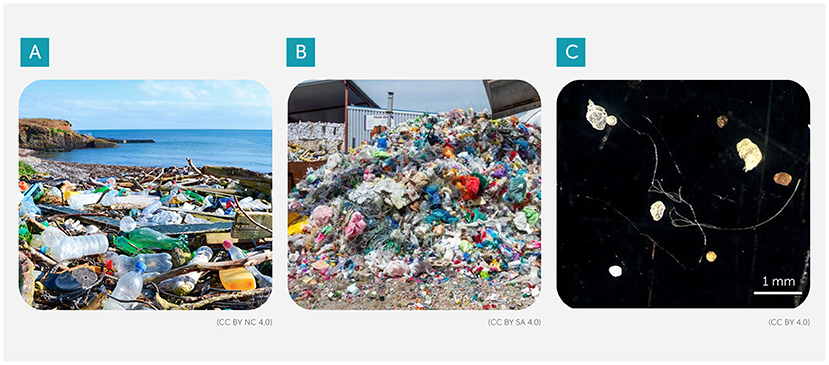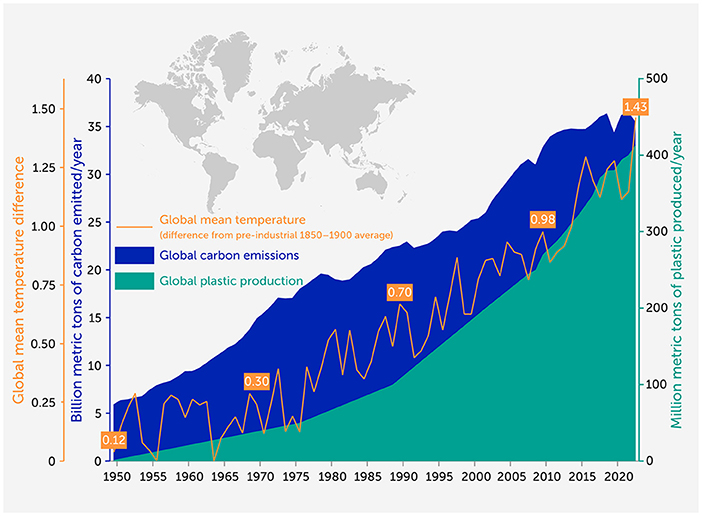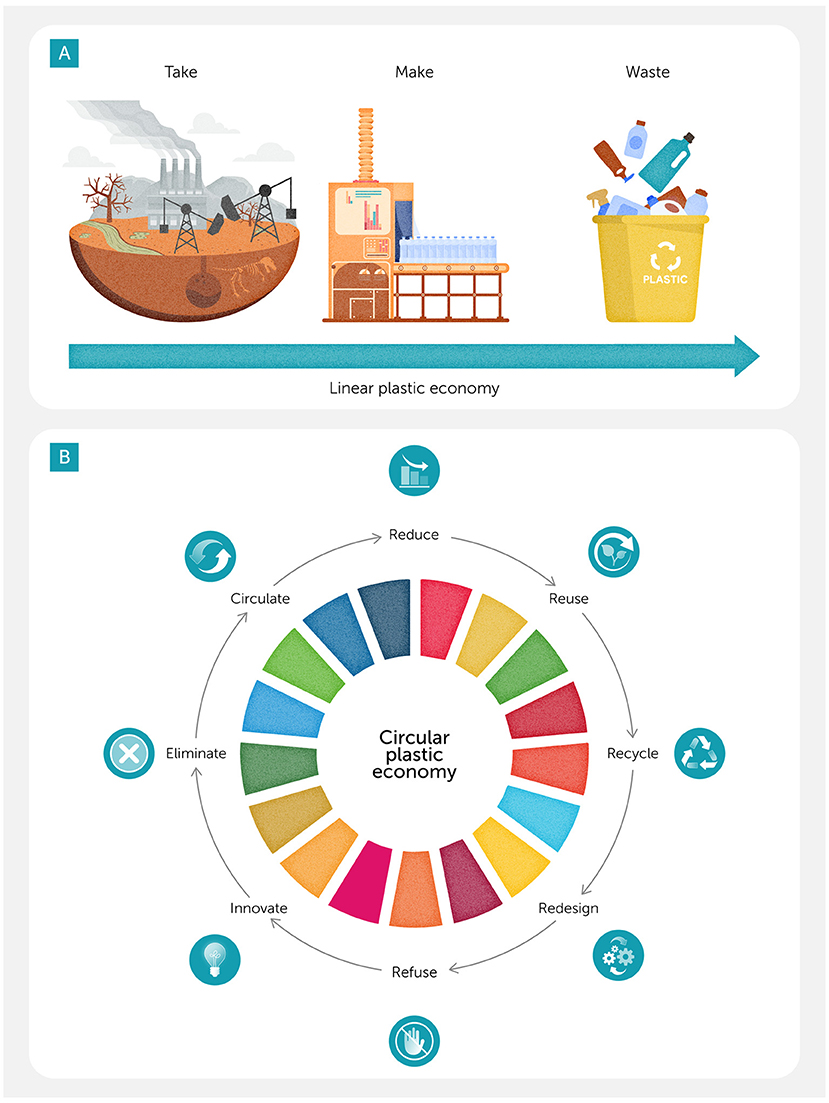Abstract
Plastics are everywhere in modern life, from clothing and packaging to medical supplies and electronics. Their usefulness comes with a major downside: plastics do not break down easily and often escape into the environment, where they fragment into tiny microplastics and nanoplastics that spread through water, air, soils, and even living organisms. Plastic pollution and climate change are tightly linked. Plastics are made from fossil fuels, and greenhouse gases are released when they are produced, transported, and burned as waste. Climate change then makes plastic pollution worse, as hotter temperatures, stronger storms, and melting ice release more plastics into ecosystems. In this article, we will explain these connected problems and how they can stress wildlife, damage ecosystems, and even threaten human health. We will also explore possible solutions—like recycling, reusing, and new clean-up methods—that are especially important for your generation.
Plastics are Everywhere!
Look around the room you are in right now. How many of the objects you see are made of plastic? You might list the case for your tablet or phone, the keyboard or mouse for your computer, a water bottle sitting on your desk, and maybe even the chair you are sitting on. It does not stop there—plastics are found in clothing fibers, food packaging, medical supplies, cars, and countless other items you use every day. In fact, life as we know it would be hard to imagine without them.
Plastics are human-made materials created mainly from fossil fuels such as oil and natural gas. At the chemical level, plastics are made of long chains of repeating building blocks—like beads strung together into a very long necklace. Different plastics are made of different “beads”, and manufacturers often add chemicals called additives to change how the material behaves. Additives can make plastics flexible or hard, colorful or clear, durable or resistant to sunlight.
Plastics became popular because they are strong yet lightweight, easy to shape into almost anything, and cheap to produce. That combination explains why global plastic production has skyrocketed—just a few million tons were produced per year in the 1950s, while more than 400 million tons per year are made today! But… and this is a big but… all the advantages of plastics come with a serious downside: plastics do not break down easily. If you throw away a banana peel, it will rot and return to the soil within weeks. A plastic wrapper, on the other hand, could still be around when your grandchildren are adults. And plastics that are not carefully disposed of and collected can end up in rivers, oceans, soils, and even inside animals.
The Problem of Plastic Pollution
When people finish using plastic items, some end up in landfills, some are burned, and a smaller fraction get recycled into new products. Unfortunately, a lot of plastic also escapes into the environment (Figures 1A, B). Plastic litter might blow off open trucks, overflowing garbage bins, or landfill sites. Litter dropped on roadsides, beaches, or city streets can wash into storm drains. Storms can carry plastics into rivers, lakes, and eventually the ocean. Many plastics also slowly wear down during use. Fibers break off from synthetic clothing in the wash. Tires shed tiny particles on the road. Even plastic-containing paint flakes can become pollution.

- Figure 1 - (A) Plastic litter found along a beach.
- (B) A pile of plastic trash. (C) Microplastics in sediments from a river (Images from Creative Commons, licenses listed under each).
Once plastics are in the environment, they slowly break apart. Big pieces that originate from items like bottles, bags, or food containers are called macroplastics (more than 5 mm across). As sunlight, heat, and waves hit them, they fragment into smaller microplastics—tinier than the length of a grain of rice (less than 5 mm; Figure 1C). Given enough time, microplastics can break down further into nanoplastics (less than 1 μm). Many of these plastic particles are so small they are invisible to the human eye. As larger plastic waste continues to break down, the amount of micro- and nanoplastics plastics in the environment keeps increasing. Even if we stopped producing plastic today, the billions of tons already out there would keep turning into smaller and smaller fragments for decades or even centuries.
Scientists now find plastics almost everywhere on Earth. Macroplastics are scattered along coastlines and riverbanks. Microplastics and nanoplastics have been detected in farmland soils, on the surfaces of crops, and inside the bodies of fish and shellfish. They can travel on wind currents and have been found in mountain snow, deep-ocean water, and even the air inside our homes. No ecosystem—and no person—is completely free from plastic pollution [1].
Added Threats of Plastics in a Warming World
As you already know, greenhouse gases like CO2 are building up in the atmosphere and driving climate change, which is already reshaping our planet. Plastic pollution and climate change may seem like two separate problems, but they are closely linked, and both are increasing (Figure 2). In fact, each one makes the other worse [2].

- Figure 2 - Plastic pollution and climate change are closely linked, and both are increasing.
- The blue shaded area shows the rise in carbon emissions, and the orange line shows the resulting rise in global mean temperature from 1950 until today, due to buildup of greenhouse gases in the atmosphere. The green shaded area illustrates the increase in global plastic production. You can clearly see that all three factors have been trending upwards over time.
It is well-known that plastics add to climate change. Almost all plastics are made from fossil fuels, and greenhouse gases are released at every step—from drilling and transporting the fuel, to producing the plastic, to burning or breaking it down at the end of its life. Today, plastic production uses about 12% of the world’s oil supply, and that number is expected to rise. If we keep making plastics at this pace, greenhouse gas emissions from plastics could double or even triple in the coming decades.
Interestingly, the connection also runs the other way. Hotter average temperatures, stronger sunlight, heavier storms, longer droughts, rising seas, melting ice, and more frequent wildfires are all signs of a warming world. Each of these forces can worsen plastic pollution [2, 3]. Heat and sunlight cause plastics to crack and fragment more quickly. Stronger storms and floods can wash large amounts of plastic litter from land into rivers and oceans. Rising seas can erode old landfills on coastlines, releasing plastics that have been buried for decades. And, as ice melts in the Arctic, microplastics that were once frozen in ice sheets may be released into the ocean.
Scientists have been studying how plastics contribute to climate change for years. But research on how climate change increases plastic pollution is much newer. Early studies suggest that when the two problems act together, their combined effects on wildlife, people, and the environment are hard to predict and can often be worse than either one alone. This raises an urgent question: what happens to living things when plastic pollution and climate stress pile on at the same time?
Combined Impacts on Nature and People
In the oceans and in fresh water, plastics are often eaten by fish, seabirds, turtles, and whales. Large pieces can choke animals or block their stomachs, while smaller microplastics and nanoplastics can pass into blood and tissues, releasing the additives they carry, which can be harmful to the health of living things or the environment [1]. Plastic particles can even carry disease-causing microbes. Climate change magnifies these impacts. Warmer waters can stress animals already coping with pollution, and stronger storms add sudden surges of plastic debris to coasts and rivers. These combined pressures leave wildlife less able to recover, tipping ecosystems further out of balance [4, 5].
Warmer waters can also speed up the feeding of tiny organisms like plankton and filter-feeding shellfish, which may cause them to take in more plastic. In fresh water, small creatures like algae and water fleas can be stressed or even die when exposed to both heat and plastic particles. Because these organisms form the base of the food web any harm to them can ripple upward to larger animals [6]. At the top of the food web, long-lived predators like whales, turtles, and large fish face higher risks because they accumulate plastics in their bodies over many years, by eating prey that already contain these contaminants.
Meanwhile, keystone species (those that hold ecosystems together) and ecosystem engineers (species that build or shape habitats, like corals that build reefs or shellfish that filter water) are the foundation for many other organisms. When these species are harmed, countless others lose their homes or food sources. For example, corals already stressed by warmer waters are less able to cope with plastic pollution, which can block sunlight and carry disease, putting entire reef ecosystems at risk.
On land, interactions are harder to predict but still concerning. Plastics enter soils through litter, wastewater, and farming practices like using plastic mulch on fields. Microplastics can change how soils hold water and nutrients. Early studies suggest that crops like rice may grow less well when exposed to both heat stress and plastic fragments—hinting that climate change and plastic pollution together could threaten food security.
Humans are part of this story, too. While scientists are still studying the health effects of micro- and nanoplastics, these particles have already been found in drinking water, table salt, and even human blood. Because we depend on healthy ecosystems for food, clean water, and stable climates, the damage to nature ultimately comes back to us.
What Can We do About It?
Neither climate change nor plastic pollution has an easy solution—but both can be tackled if we change the way plastics are designed, used, and managed.
Unlike glass, aluminum, or paper, plastics are difficult to recycle. They often lose quality when they are melted down, and recycling can be more expensive than making new plastic. That is why only about nine out of every 100 plastic items ever get recycled. Experts call this a linear economy—a system of take–make–waste. We take fossil fuels from the Earth to create plastics, make products that are often used just once, and then waste them by throwing them away (Figure 3A).

- Figure 3 - (A) In a linear plastic economy we take fossil fuels from the Earth to create plastics, make plastic products that are often used only once, and then throw them away as waste after we use them.
- Only about nine of every 100 plastic items gets recycled, resulting in pollution. (B) In a circular plastic economy, plastics would be redesigned to be safely reused and recycled. This could reduce new plastic production, generate less plastic litter, and minimize environmental plastic pollution and greenhouse gas emissions.
A better option is a circular economy, where plastics are carefully designed to be safely reused and recycled over and over again (Figure 3B). In this system, materials stay in use instead of becoming waste. A circular economy would mean fewer new plastics made from fossil fuels, less litter piling up in landfills, and less plastic pollution leaking into the environment. It would also lower greenhouse gas emissions, helping slow the climate change that makes plastic pollution worse.
For cleaning up the pollution we already have, bioremediation can be used to remove plastics from wastewater in treatment plants, before it is released back into the environment. Bioremediation uses living things to help break down plastics. Certain bacteria, fungi, and even algae can produce chemical “scissors” that cut apart the long chains, turning plastics into simple molecules that the microbes can use as food. Unlike sunlight, heat, and waves, which only break plastics into smaller and smaller pieces, bioremediation could break them down completely. While this method is still being researched, it could one day offer a cleaner, greener way to deal with the huge amounts of plastic waste humans generate daily.
Looking Ahead—Your Generation Matters!
Plastics are not going away anytime soon. They are too useful and too deeply woven into modern life. But the way we make, use, and dispose of plastics can change—and it must, if we want a healthier planet. People everywhere are working on solutions, from rethinking product design to working on international agreements. But education is one of the most powerful tools. When people understand the problem, they are more likely to act—and the earlier that understanding starts, the stronger the impact can be. That is why teaching kids and teenagers about plastic pollution is so important. Your generation will give rise to future inventors, voters, and community leaders who can imagine and demand better solutions. Even small steps, like saying “no” to unnecessary single-use plastics or joining a cleanup project can make a difference—and can inspire others to do the same. If enough people learn, care, and act, we can keep the benefits of plastics without drowning the Earth in plastic waste. The future of plastics—and the planet—really is in your hands.
Glossary
Fossil Fuels: ↑ Energy sources like coal, oil, and gas formed from ancient plants and animals. Burning them gives us power but also releases greenhouse gases.
Food Web: ↑ A map of who eats whom in nature, showing how energy moves through plants, animals, and microbes in an ecosystem.
Keystone Species: ↑ A species that has a big impact on its ecosystem. If it disappears, many other plants and animals are affected.
Ecosystem Engineers: ↑ Animals or plants that change their environment in major ways, like beavers building dams or trees creating shade.
Linear Economy: ↑ A “take, make, throw away” system where resources are used once and then discarded as waste.
Circular Economy: ↑ A system where resources are reused, repaired, or recycled to reduce waste and keep materials in use for as long as possible.
Bioremediation: ↑ Using living things, like plants, fungi, or bacteria, to clean up pollution in soil, water, or air.
Conflict of Interest
The authors declare that the research was conducted in the absence of any commercial or financial relationships that could be construed as a potential conflict of interest.
Acknowledgments
Edited by Susan Debad Ph.D., graduate of the UMass Chan Medical School Morningside Graduate School of Biomedical Sciences (USA) and scientific writer/editor at SJD Consulting, LLC. The authors declared that financial support was received for this work and/or its publication. FJK, SLW and JCF received funding from the MRC Centre for Environment and Health, which is funded by the Medical Research Council (MR/S0196669/1, 2019–2024). The views expressed in this work are those of the author and not necessarily those of Medical Research Council.
Author Disclaimer
The views expressed in this work are those of the author and not necessarily those of Medical Research Council.
AI Tool Statement
The author(s) declare that no Gen AI was used in the creation of this manuscript.
Any alternative text (alt text) provided alongside figures in this article has been generated by Frontiers with the support of artificial intelligence and reasonable efforts have been made to ensure accuracy, including review by the authors wherever possible. If you identify any issues, please contact us.
Original Source Article
↑Kelly, F. J., Wright, S. L., Woodward, G., and Fussell, J. C. 2025. Plastic pollution under the influence of climate change: implications for the abundance, distribution and hazards in terrestrial and aquatic ecosystems. Front. Sci. 3:1636665. doi: 10.3389/fsci.2025.1636665
References
[1] ↑ MacLeod, M., Breitholtz, M., Cousins, I. T., De Wit, C. A., Persson, L. M., Ruden, C., et al. 2014. Identifying chemicals that are planetary boundary threats. Environ. Sci. Technol. 48:11057–63. doi: 10.1021/es501893m
[2] ↑ Arp, H. P. H., Kühnel, D., Rummel, C., Macleod, M., Potthoff, A., Reichelt, S., et al. 2021. Weathering plastics as a planetary boundary threat: exposure, fate, and hazards. Environ. Sci. Technol. 55:7246–55. doi: 10.1021/acs.est.1c01512
[3] ↑ Ford, H. V., Jones, N. H., Davies, A. J., Godley, B. J., Jambeck, J. R., Napper, I. E., et al. 2022. The fundamental links between climate change and marine plastic pollution. Sci. Total Environ. 806:150392. doi: 10.1016/j.scitotenv.2021.150392
[4] ↑ Jackson, M. C., Pawar, S., and Woodward, G. 2021. The temporal dynamics of multiple stressor effects: from individuals to ecosystems. Trends Ecol. Evol. 36:402–10. doi: 10.1016/j.tree.2021.01.005
[5] ↑ Woodward, G., Perkins, D. M., and Brown, L. E. 2010. Climate change and freshwater ecosystems: impacts across multiple levels of organization. Philos. Trans. R Soc. Lond. B Biol. Sci. 365:2093–106. doi: 10.1098/rstb.2010.0055
[6] ↑ Hagen, M., Kissling, W. D., Rasmussen, C., De Aguiar, M. A. M., Brown, L. E., Carstensen, D. W., et al. 2012. 2 – Biodiversity, species interactions and ecological networks in a fragmented world. Adv. Ecol. Res. 46:89–210. doi: 10.1016/B978-0-12-396992-7.00002-2
